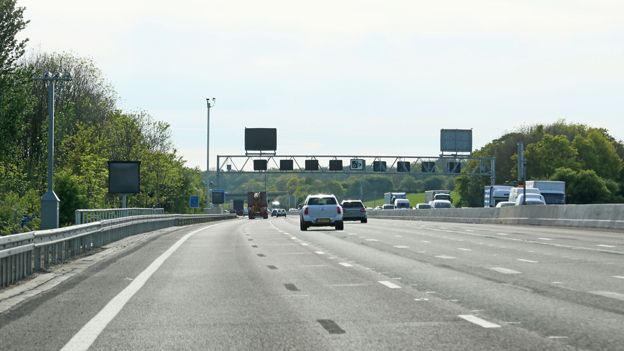Who, What, Why: How 'stealthy' are the new speed cameras?
- Published

A set of verification cameras on pole (far left). In distance, a single enforcement camera and radar gun to left of gantry (halfway up)
There has been alarm about new "stealth" speed cameras. Just how "sneaky" are they, asks Tom de Castella.
It goes by the snappy name Highways Agency Digital Enforcement Camera System 3, or Hadecs 3 for short. The new speed camera system was installed in April 2014 between junctions five and six on the M25 in Kent, near Clacket Lane Services. But it only became operational on 22 October. By 15 January - less than three months later - 1,513 people had been caught. One of the biggest complaints is that they are painted grey rather than yellow.
The Daily Mail warned: "Watch out, new stealth cameras on motorways." It noted that the high tech camera system will soon be expanded to other motorways, external.
Hadecs 3 differs radically from older systems. A single camera and radar gun are attached to the gantry or a pole at the side of the road. They can cover all the lanes of a motorway carriageway. About 200 metres away is a set of cameras that takes a wide angle photograph for more detailed verification - they will take a shot of the speed limit on the gantry signs and the car.
It can cover all the lanes of a motorway carriageway from a single camera mounted on the grass verge or a gantry. If the vehicle is breaking the speed limit the camera takes two photographs of the registration number.
In contrast, the average speed system, external requires a pair of cameras for each lane, to catch the car entering and leaving a controlled zone.
Critics of the new system say that unlike the yellow boxed speed cameras of old, its grey colour makes it hard to spot - "stealthy" even.
The Highways Agency rejects this. It may be grey. But so was predecessor Hadecs 2 - in operation on the M25 near Heathrow. And Hadecs 3 is accompanied by signs warning motorists of speed cameras ahead.
The M25 in Kent has been chosen because it is part of the government's Smart Motorways policy - where the hard shoulder is used and variable speed limits enforced. Similar cameras operate on the M25's northern section between junctions 23 and 27. And they will soon be rolled out to other Smart Motorway sections - the M1 (in Derbyshire and South Yorkshire), M6 (around Birmingham) and a stretch of the M3.
A lot of people have been caught in a short space of time. Of the 1,513 drivers logged by the new cameras, 781 had exceeded a speed limit of 70mph, according to Kent Police. The other 732 had broken a limit of either 40, 50 or 60mph. The Highways Agency says the people caught are a small proportion of the "hundreds of thousands of motorists [who] use this stretch of the M25 every day". But without knowing how many motorists were caught by the old camera systems on a similar stretch of motorway, it's hard to say whether more drivers are being caught by Hadecs 3.
Subscribe to the BBC News Magazine's email newsletter to get articles sent to your inbox